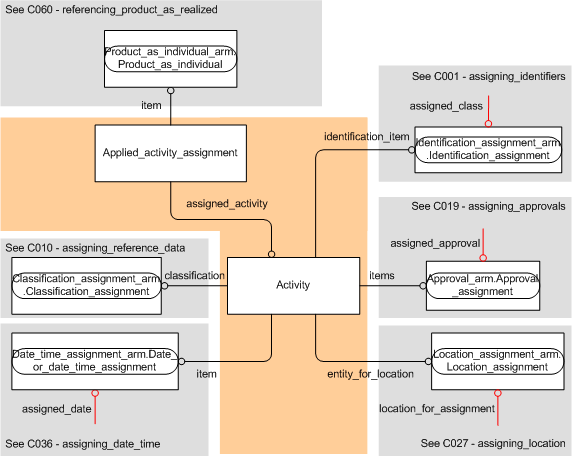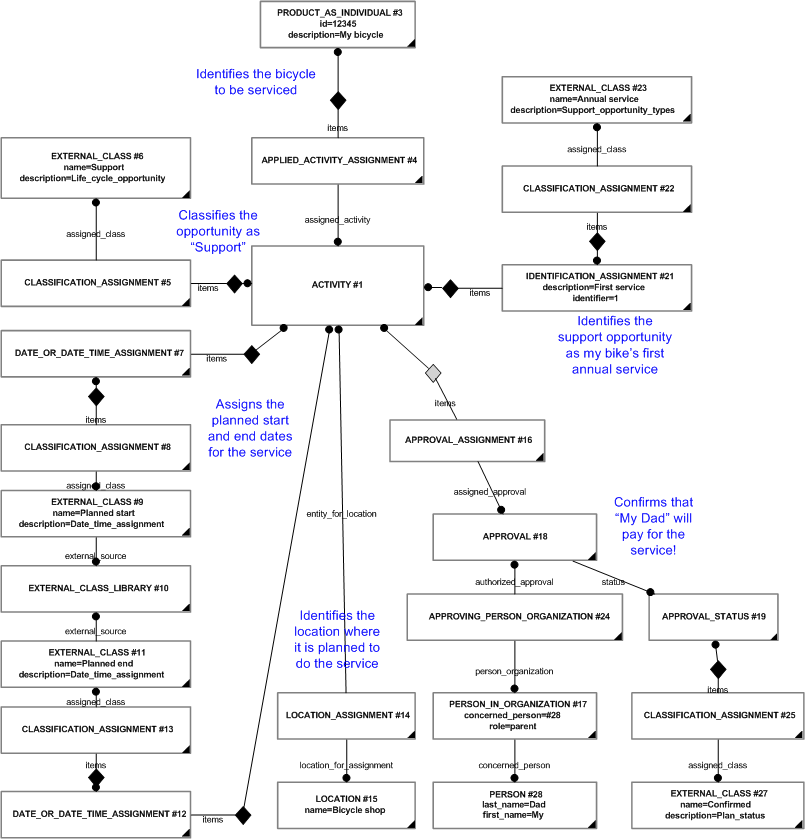| Capability (C020):— representing_life_cycle_opportunity |
Date: 2007/07/11 16:32:00
Revision: 1.18
|
This section provides a business level overview of this capability.
This capability assumes that, for every Product_as_individual, there is a Person, acting in the role of a planning authority and tasked with managing the usage of that product throughout its life, from
concept to disposal. It also assumes that such an authority will wish to define specific periods in that life cycle, to which
information that characterises the intended nature of each period can be attached. Such periods, given identity and definition
by this Capability, are not mutually exclusive. For example, a military system may be assigned to NATO between a pair of dates
while also being classified as non operational and available for maintenance for a defined support period within the same
timeframe.
This section provides an overview of the information model that supports
this capability.
The information required to represent a window of opportunity in the life cycle of a product is summarized in the diagram
at Figure 1 below and described in the following sections.
The EXPRESS-G shaded in grey is out of scope for this capability but is included for completeness to identify dependant or
related Capabilities. These address the identification of the target for the work (referencing_product_as_individual
![[warning:]](../../../../images/dex/warning.gif) Error C1: Capability referencing_product_as_individual not in dex_index.xml
Error C1: Capability referencing_product_as_individual not in dex_index.xml
), the classification of the opportunity (C010: assigning_reference_data), the identity given to the opportunity (C001: assigning_identifiers), the planned location of the life cycle opportunity (C027: representing_location) and the identity of the person or organization compiling the package (C016: representing_person_organization.
Figure 1 — Window of Opportunity in the Life Cycle of a Product
Each window of opportunity is modelled by making an Applied_activity_assignment to the Product_as_individual. The exact nature of each planned opportunity is determined by classification from an external class library through Capability
C010: assigning_reference_data. For subsequent reference, each opportunity is assigned an identifier using Capability C001: assigning_identifiers.
The assignment of dates and times is described in the capability: C036: assigning_date_time.
Dates associated with the opportunity are represented by the assignment of one or more
Date_times or Calendar_dates to the planned Activity by using a Date_or_date_time_assignment.
At a minimum, a "planned start date" should be defined, but additional dates, such as "planned end date", "actual start date"
and "actual end date" could be appropriate. Capability C036: assigning_date_time describes how the role of a date declaration can be determined, using classification from an external reference data library.
Depending upon the natures of both the product and of the opportunity, it is generally desirable to be able to declare where
the activity will be undertaken. It should be noted that the location, if declared, is considered within this Capability to
be an attribute of the planned activity to which the product has been assigned and not an attribute of the product itself.
The status of the information defining the opportunity is established by the assignment of a qualified approval. The identity
of the person or organisation that has the authority to plan the life cycle of the product is determined using Capability
C016: representing_person_organization. This authority is then associated, through the capability: C019: assigning_approvals with the status declared for the planned product activity.
An example of a "Window of Opportunity" for the repair of a bicycle is shown in the Instance Diagram at Figure 2.
Figure 2 — Window of Opportunity for the Repair of a Bicycle
The following sections define a set of templates for the capability,
where a template is a specification of a set of entities that need to
be instantiated to represent a given set of information.
This section specifies the template assigning_life_cycle_opportunity.
NOTE
An explanation of a template and the associated instantiation path is
provided in the
Template overview
section.
![[warning:]]() Error Txt: The template description must start with: <p>This template describes .... Not: This template defines an activity
(opportunity) and relates it to a directive.
Error Txt: The template description must start with: <p>This template describes .... Not: This template defines an activity
(opportunity) and relates it to a directive.
This template defines an activity (opportunity) and relates it to a directive.
The EXPRESS-G diagram in
Figure
shows the templates and EXPRESS entities that are required
to represent the template
"assigning_life_cycle_opportunity".
The text highlighted in blue shows the template parameters.
Figure 1 —
The following input parameters are defined for this template:
![[warning:]](../../../../images/dex/warning.gif) Error Param1: Parameter must be a STRING, NUMBER, INTEGER, REAL, BOOLEAN,
ENUMERATION, LOGICAL, CLASS, URN, URL, ENTITY, TYPE or SELECT
Error Param1: Parameter must be a STRING, NUMBER, INTEGER, REAL, BOOLEAN,
ENUMERATION, LOGICAL, CLASS, URN, URL, ENTITY, TYPE or SELECT
The instantiation path shown below specifies the entities that are to be
instantiated by the template.
The instance diagram in Figure
shows an example of the EXPRESS entities and templates that are instantiated by the template:
Figure 2 —
No common characterizations of the template
assigning_life_cycle_opportunity
have been identified. However, the ISO 10303-239 EXPRESS model
may enable other assignments to the entities instantiated by the template.
This capability
"Representing a Window of Opportunity in the Product Life Cycle" is related to the
following capabilities:
![[warning:]](../../../../images/dex/warning.gif) Error C1: Capability referencing_documents not in dex_index.xml
Error C1: Capability referencing_documents not in dex_index.xml
This capability
"Representing a Window of Opportunity in the Product Life Cycle" is dependent on
the following capabilities:
The following classes of reference data are required for this capability:
[life_cycle_opportunity]
![[warning:]](../../../../images/dex/warning.gif) Error RDL1: The class life_cycle_opportunity does not exist in RDL at URI urn:plcs:rdl:std. Check the dexlib/data/refdata/rdl_index.xml
Error RDL1: The class life_cycle_opportunity does not exist in RDL at URI urn:plcs:rdl:std. Check the dexlib/data/refdata/rdl_index.xml

